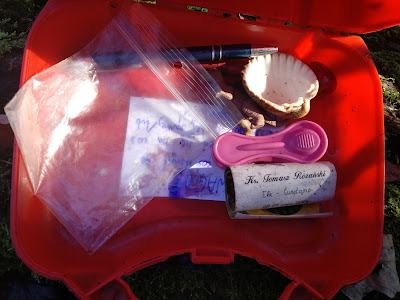I always loved to solve riddles and puzzles. I think this was one of the things that pushed me on subject of security. This was probably also why 2 months ago I took interest in geocaching. I had heard the term before once or twice but only then checked what it was about.
What is geocaching?
Geocaching is an outdoor game, in which participants try to find containters (caches) hidden all around the world. Some of them (traditional caches) require you only to check GPS coordinates and look around to find it. Others (mystery and multicaches) will require solving puzzles or gathering information about a given place or subject. All you need to start your geocaching adventure is smartphone with an app (I recommend c:geo for Android) or gps receiver and geocaches list (largest site is geocaching.com). Now you just need to go to given coordinates (or calculate them from puzzle) and look for a cache. It is easier said than done, believe me. Some of the caches are so well hidden that you will go to coordinates, search the place for half an hour and leave with nothing. After you find it, you can write your name in logbook and trade some stuff which may be inside the cache.Geocaching is a great way to visit new places (even close to your home) that you wouldn't visit otherwise. You can also learn a lot about people, places and their history. I think it is really cool combination of outdoor game and puzzle solving. It's also quite funny when I see muggle (people who don't know about geocaching) who happened to spot me while looking for a cache. You can clearly see that they are wondering why are you looking inside bushes.
And yes, sometimes they come and ask what am I doing. One more thing that always makes me smile is when I see someone with phone examining trees or fences. You instantly know that they are here to find geocache.
There is more to it though. You can, for example, send trackable items to other places via geocaches. You place item in one cache and give it destination. Other players will move it from one cache to another until it reaches its destination. I have sent Octopus Traveller which tries to visit as many capital cities as possible.
There is more to it though. You can, for example, send trackable items to other places via geocaches. You place item in one cache and give it destination. Other players will move it from one cache to another until it reaches its destination. I have sent Octopus Traveller which tries to visit as many capital cities as possible.
An unexpected journey
My adventure with geocaching began on 23 Sep 2016. I decided to take longer way home and get my first cache. It took me 10-15 minutes to find it.
I thought it was fun and after few more caches I introduced 2 of my friend to geocaching. Quite often we go caching together but sometimes even 3 people are not enough to find a cache or solve a puzzle. Even though I don't always find caches on my first try, it is very rewarding when you finally get it. So far the most difficult cache that I found was CT32 Ordynacka. I needed 3 attempts to find it but I have a feeling that there will be caches where I will need more than that. And that's just finding cache where I knew coordinates. It gets even more difficult when you need to solve a puzzle. I love riddles. I solved many logic and cryptographic puzzles before (for example on BrainQuest or WeChall) but I still can't get my head around some riddles from mystery caches.
One more thing I would like to note is my first STF (Second to find) which I got from fantastic cache "Rezystory". To find it you need to find a circuit and do some measurements and calculations.
|
|
I calculated coordinates of the cache and went to get it. Here I got my first STF certificate. I hope to get FTF as soon as possible though.
Caches
To give you idea how they look like, here are some of the caches I have found so far.
Some are big and bright...
...others are very small

|

|
Hiding in every corner
Containing interesting stuff
Milestone
After 52 days I have finally reached the milestone of finding 100 caches. This made me eligible to get first PTTK badge.
At the time of writing this post I have 132 caches found. If you are registered, you can find my profile here: Thun0
And if you are interested, register at geocaching.com






















